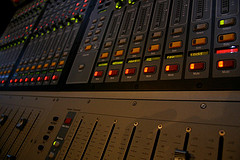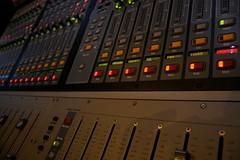
Breaking the Addiction
Sorry I’ve been away. I’ve got a lot on my mind, and I’m trying to get it all organized to maybe write about at some point. In the meantime, here’s a relatively quick one. I hate to call this a New Year’s resolution or a goal for 2010; it’s just something I’m working on this year. You see, I have an addiction, and that addiction is called Solo-In-Place.
I can’t exactly remember when it started, but Solo-In-Place (SIP) is something that I I know turned into a problem for me. Not every console has the feature so for those unfamiliar, SIP is essentially the ability to cue up a channel or channels in your PA. When SIP is engaged on a console, pressing the Solo or Cue or AFL button on a channel will mute all other channels in your PA. It can be a great tool, but I fear it is also easily overused.
Last year I started working on cutting back my SIP use, but I’ve been motivated more lately by some interviews I’ve been reading with some big name record mixers. A lot of those guys stay away from the solo button when they’re mixing and prefer to only work on things in context. After all, that’s the way things will be heard when the record comes out.
Of course, things can be a little different in a sound reinforcement scenario. While a portion of what I do as a mixer will only be heard in context of a song, there are also instruments I know at any given time might be naked in the PA. These can be things like lead vocals, acoustic guitars, and keyboards. So one of our challenges in sound reinforcement is to somehow make these sound good within the context of a full mix while also being able to stand alone if necessary. SIP can be a great tool for checking how these things will sound on their own. SIP can also be a great troubleshooting tool to identify specific problems with a sound.
However, once exposed to SIP, it can be very easy to start working on everything primarily using SIP. Once you start down that road, I feel you must be very cautious. When we start working on every sound in isolation, we aren’t mixing. Mixing is about blending things. It’s layering and making space. It’s how everything sounds together, and that can’t happen listening to each sound in isolation. Don’t get me wrong, if you have everything sounding really good, it’s been my experience that you can push up and balance faders and have things in pretty good shape. However, if I need to get stuff to play nice together, I need to work on everything together.
So one of the challenges for myself this year is to spend the majority of my time mixing things within the context of the mix. What are you guys working on this year?


 Previous Post
Previous Post



Great thought. I’ve often found that what makes an instrument sound good solo (such as a full-bodied acoustic guitar sound) is very different for what makes it sound good in the context of a mix (such as how muddy the bass in that acoustic guitar could make the entire band sound).
This year, I’m working on my Pro Tools skills and am trying to expand creatively.
One of the things I like about our FOH setup is the set of NS-10s on either side of the console. Rather than solo stuff to the mains, I can put them in the NS-10s. Often times, I need to hear something a little clearer to figure out what’s going on with it, but unless I really crank up the cue level, it remains essentially in the mix.
For me, I’m working on creating sonic space for everything in the mix. I’ve heard so many mixes that are just a wall of sound coming from the stage; as if everything is just turned up to 11. Lately, I’ve been trying to work on placing sounds in their on space so that it either blends in with something else, or can be heard distinctly without strain. When I get it right, the mix “opens up” and everything falls beautifully in to place; this past weekend was a good one. Best of all, it can sound great without being too loud.
I think that making things fit in a mix is skill that can be developed by focusing on having a little “acoustic memory.”
If I have too much midrange in piano (a common mix context problem) I can still solo the channel to nail down which frequency range will be the best to thin out. If I can pick the half octave where I want to attack the problem, and mentally retain that, I find it sufficient to do something that makes sense against the whole mix. Realizing the piano needs a cut between, say 400-600Hz, and then soloing the piano to get context in that specific range usually, for me, results in a cut that makes sense in the larger mix context. This can be jumped through pretty quickly during a sound check.
I find SIP in place preferable to slamming a set of earphones over my ears and trying to do essentially the same function against the backdrop of the whole mix blaring outside (the typical PFL setting).
Where there is no sound check to speak of, I will use PFL extensively to work on attack/release times. Basic channel levels and eq first, then in the second or third song, PFL of the relevant channels to try to get the dynamics processing doing what I want. Lastly, verbs and/or delays.
I have recently undergone a transition between our worship spaces. We are about to lose a campus, only to move a service we have to another church facility (not our own and not enough head room to support our youth, blah!). We are putting our College ministry right in front of our mid week service (pro and con: Can we say, 30 min setup time. But pro, can we say, Martin Audio rig with D-show Profile!?). So, my biggest thing is, I DO TWO OF THOSE SERVICES A NIGHT. I need to be flexable at this time, and be able to keep my head clear for the two different venues.
Besides the chaos in the beginning of this year, I am really just going through the book, “Sound Systems: Desing and Optimization,” by Bob McCarthy. Really good read and very, very easy to understand. It’s 493 pages so easily what I’m going to be working on it this year.
I train techs and mix FOH in a 24/7 worship environment, so SIP isn’t an option, except in broadcast audio. Usually I’ll do a quick PFL if I’m not sure what the instrument is doing (our synth and electric guitar players can get a little weird), but that’s about it– it’s all about context for me.
My goal this year is to build a clock– set things up so they run on their own, rather than just telling everyone what time it is. I haven’t been good at hiring and delegating, so that’s priority #1 so I don’t run myself into the ground.